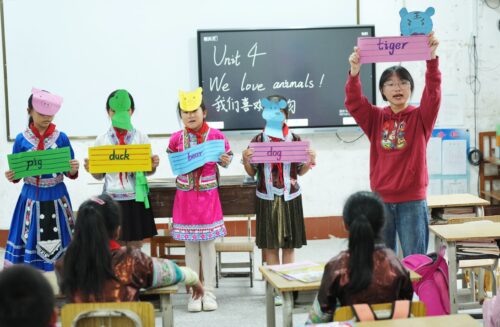China’s global education strategy and the growing divide between East and West
Western critics of China have put a lot of scrutiny on Confucius Institutes, saying these schools of language and culture create CCP “echo chambers” that disseminate political ideology. But Beijing’s global education strategy is a lot more comprehensive than a network of CIs — and a lot less sinister.

Debate around Confucius Institutes (CIs) has resurfaced in the UK. Two weeks ago, Rishi Sunak rescinded a pledge made last year to issue a complete ban on CIs, but he confirmed that sponsorship of Mandarin learning in schools will be dropped. Instead, a new program providing British civil servants with “China expertise in the tech and military sectors” will be introduced from 2024.
Britain’s recent hostility toward CIs is representative of growing criticism among Western powers of the Chinese Communist Party’s involvement with educational institutions abroad. Beijing’s overseas education strategy has developed rapidly over the past 10 years, in tandem with its Belt and Road Initiative, where education plays a key role.
CIs form just part of the picture. Beijing’s overseas commitments include partnerships with foreign universities and institutes, provision of scholarships, training of local teachers, and even building new schools.
But as Western powers turn their backs on China’s education initiatives, BRI partner countries are welcoming educational opportunities offered by Beijing. What implications does this growing divide have for China’s global educational strategy? How might it influence bilateral ties between BRI-partnering countries and China in the years to come?
Confucius Institutes across BRI partner countries
The presence of Confucius Institutes across the world — establishments teaching Chinese culture and language to students overseas — has been increasing since 2008. But the BRI, officially launched in 2013, has accelerated and concentrated their growth, most prominently in Southeast Asia and Africa. Currently, there are 61 institutes across the African continent, built between 2005 and 2018. Just last month, Djibouti opened a new CI within a high school campus, a partnership between Chinese Sichuan Normal University and the Djibouti National Education and Vocational Training Department. A former teacher at a CI in the University of Lagos, Damilola Ilori, explained how the number of young adults studying Mandarin had increased significantly across the past five years. The institute currently has more than 250 students and nine teachers (of which five are Chinese and four local).
Concerns around CIs in the West are grounded in the perception that they are “echo chambers” for the Party, disseminating political ideology and social values. However, a closer look at the curricula and language attainment levels of CI students reveal their programs are unlikely to wield political influence.
The focus of these CIs is “to improve language proficiency,” Ilori says. Programs in Lagos extend beyond exam preparation for Hanyu Shuiping Kaoshi (HSK) to include business Mandarin and youth classes for those aged 6 to 18. Although there are cultural courses, including cooking and Tai Chi, language acquisition is prioritized.
Gibson Simel, a former employee of the Kenyan branch of Vivo (one of China’s leading phone companies), was a student at the University of Nairobi’s Confucius Institute. After passing levels 1 and 2 of Mandarin proficiency under the institute, Simel went on to work at Vivo as a sales representative.
Chinese companies “have a preference for people who have studied a bit of Chinese,” Simel says. On-campus Confucius Institutes play a key role in recruitment, and facilitate “collaboration between universities and the Chinese enterprises,” who together organize career fairs to recruit talented graduates. The institutes therefore have much more of a developed role in BRI partner countries, being keystones to social and economic cooperation.
Investment into BRI research centers and technological advancement
Farrukh Evin has an academic background as a chemical engineer. After completing his undergraduate studies, he went on to obtain a Masters and Ph.D., specializing in the field of chemistry and the environment. While at Islamabad University, he was presented with a unique research opportunity. The Belt and Road Institute at the Chinese Academy of Sciences (CAS) in Tianjin offered him a scholarship worth 500,000 yuan ($71,000) to pursue research in industrial biotechnology.
Within two years, Evin is expected to develop new technology for producing value-added products from waste, reducing production time and cost by 80%. Evin has already isolated 91 bacterial strains, and is currently optimizing his new technique in order to produce at scale. When asked what his research would contribute, Evin’s reply was confident. “Through cooperative research, there will be an expansion of scientific and technological partnership between China and Pakistan and local schools.”
Similar research institutes have been established in many of China’s leading universities, including Tsinghua and Peking University in Beijing, and Fudan University in Shanghai. Programs prioritize target sectors such as science technology, artificial intelligence, and advantaged technology. CAS has invested 1.8 billion yuan ($268 million) toward Belt and Road science and technology projects, and has created a network of 40 partner institutes across 14 different countries. The stated aim of these research centers is to advance “the application and transfer of sci-tech achievements in countries along the route, driving regional and sub-regional economic and social development.”
Collaborative, BRI-focused research institutes are not limited to China. The Belt Road Research Centre (BRRC) in Bangkok is one of many collaborative research centers established across target regions with a focus on science, technology and sustainability. This center in particular focuses on developing pioneering technology and research around environmental sustainability. Exchanges between Chinese and Thai research teams have picked up since China’s opening up at the beginning of this year, signaling continued interest in investing resources into such research centers.
Using education to strengthen political connections
China’s educational strategy ultimately aims to improve political, economic, and social ties between Beijing and political elites of target countries. Besides science and technology, there are lots of courses on governance and economic development. The Belt and Road Institute at Fudan University provides courses such as “International Security,” “Global Governance,” and “Industry and Investment.” Tsinghua University hopes that its partner One Belt One Road Strategy Institute will “become an indispensable think tank, pioneer, advisor and practitioner of the Belt and Road Initiative,” which “cultivate[s] high-end talents who are familiar with [BRI] countries.”
As the next generation of students take up leadership positions in both China and partner countries, linguistic expertise and academic knowledge will play a role in shaping foreign policy and deepening ties between China and target regions. This is already evident in some African countries, where growing numbers of political elites have firsthand experience of China’s educational strategy, such as former president of Ethiopia Mulatu Teshome Wirtu and Grace Mugabe, Robert Mugabe’s wife, who studied Mandarin.
This is a stark contrast to leaders in the West, who have limited personal engagement with China or China-related expertise, and are increasingly hostile toward Chinese investment in the education sector.
Across Europe, the number of those engaging in Chinese studies has stagnated. In the UK, for instance, the number of students learning Mandarin has not grown since the 1990s. Given hardening animosity, this is unlikely to change. Historically, numbers of British civil servants with China expertise have been extremely limited, the repercussions of which are only beginning to be understood. Despite Sunak’s plans to address this knowledge gap, it may be too little, too late.
Provision of scholarships and influence on future leaders
China’s generous scholarships, which often cover accommodation, living, and tuition costs, are attracting increasingly diverse international students who go into a range of fields, from agricultural technology to journalism to government. Currently, 279 Chinese universities offer scholarship programs to international students. While many students from BRI countries admit they would rather study in the U.S. or Europe, China’s offering of fully-funded programs and additional stipends can be hard to turn down.
Although the flow of students paused between 2020 and 2022 as a result of Beijing’s stringent COVID-19 measures, official statements from this year’s China Annual Conference and Expo for International Education in Beijing suggest the PRC intends to expand global educational partnership, specifically with BRI countries.
Given the extensive financial support provided, it is unsurprising that many beneficiaries of China’s scholarship programs are left with positive impressions of China. Safyan Jabbar, one of 28,000 Pakistanis who studied in China in 2019 and who was awarded a scholarship at Tsinghua, told me how the “world-class professors” and programs “exceeded [his] expectations.” For Jabbar, the greatest benefit was the course’s practical modules, which engaged Chinese think tanks, government entities, and private companies involved in BRI projects.
“This helped me understand how policy makers think,” Jabbar says. He now advises the Pakistani government and private sector organizations on BRI projects and partnership with China.
What’s next for China’s BRI educational strategy?
Beijing’s investment into international education is part of a long-term vision to deepen influence abroad and consolidate ties with target regions. As part of the Belt and Road Initiative, investment into education facilitates dialogue with local employees and politicians engaging with key infrastructure projects.
China is continuing to invest into education partnership with key countries, resulting in a widening knowledge gap between the East and West. As the next generation of students step up into leadership roles, their starkly different understanding and experiences of China will shape political decision-making. It is likely to rebalance global power dynamics, as China gains more influence with its partners and builds its vision of a multipolar world.






